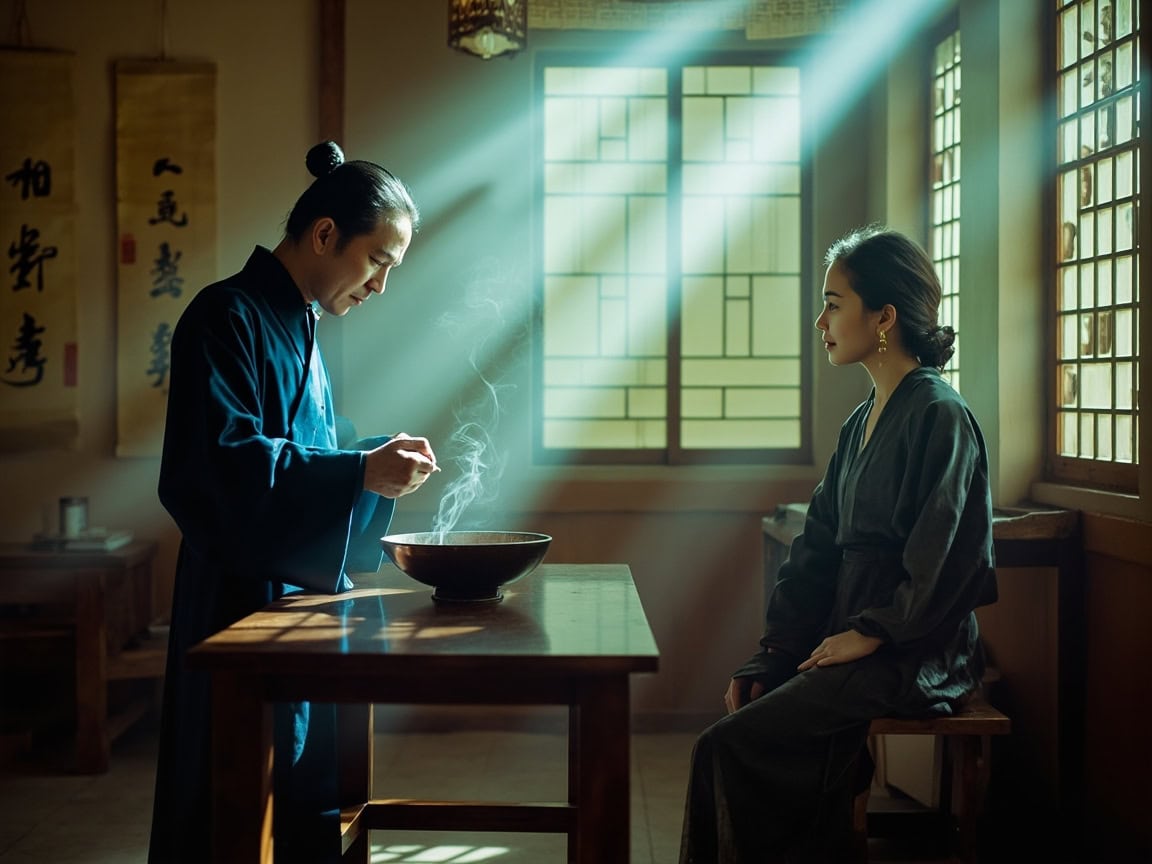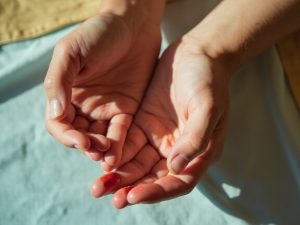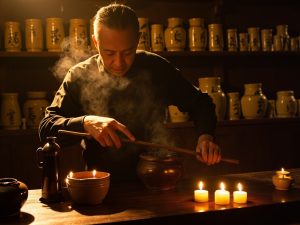Table of Contents
ToggleTraditional Chinese Medicine Case Analysis 8: Constipation, Irritability, Nausea, Fever, Headache
Author: Gu Yuxi Editor: Gu Yuxi Translator: Gu Yuxi
Traditional Chinese Medicine Case Study from “Luo Jiao Annotation of Guilin Ancient Edition of Shanghan Zabing Lun” –
Original text:
Liu, female, 27 years old. Initial consultation on June 4, 1965. Had a fever and headache for 1 week. She had previously taken Chinese and Western exterior-releasing medications, resulting in profuse sweating, but her body heat and headache did not subside. She experienced unbearable distending headache, restlessness with a desire to vomit, a craving for cold drinks, burning skin without aversion to cold, and had not defecated for 3 days. Her tongue coating was thick and white, and her pulse was wiry and slightly rapid. Her body temperature was 38℃. The diagnosis was internal excess heat with disharmony of the stomach. The treatment principle was to clear internal heat and harmonize the stomach. Tiao Wei Cheng Qi Tang was prescribed: Da Huang (Rhubarb) 10g, Zhi Gan Cao (Prepared Licorice) 6g, Mang Xiao (Glauber’s Salt) 12g (dissolved separately). After taking the first decoction, her bowels moved, her headache resolved, her body heat decreased, and her temperature returned to normal. She continued to take the remaining medicine without Mang Xiao, and her symptoms largely disappeared. — Jing Fang Chuan Zhen (Transmission of Classical Formulas)
【Traditional Chinese Medicine Syndrome Differentiation Approach】:
Differentiation of the Six Diseases:
- Dysuria/Spontaneous Diarrhea: None.
- Tai Yang Disease: None. (Burning skin without aversion to cold)
- Yang Ming Disease: Present. (Fever, headache, unbearable distending headache, restlessness with a desire to vomit, craving for cold drinks, burning skin. No bowel movement for 3 days.)
- Shao Yang Disease: None.
- Shao Yin Disease: None.
- Tai Yin Disease: None.
- Jue Yin Disease: None.
Differentiation of Miscellaneous Diseases:
- Qi Deficiency: None.
- Blood Deficiency: None.
- Water-Dampness: None.
- Food Stagnation: Present. (No bowel movement for 3 days, thick white tongue coating, wiry and slightly rapid pulse.)
- Phlegm Obstruction: None.
- Blood Stasis: None.
- Other Miscellaneous Diseases: None.
Summary: This case primarily involves Yang Ming disease, accompanied by pervasive intense heat characteristic of Yang Ming disease, and food stagnation. In the Shanghan Zabing Lun, the distinction between Tai Yang disease and Yang Ming disease is made as follows: — [7.25] For cold damage with no bowel movement for six or seven days, headache, and fever, administer Cheng Qi Tang. If the urine is clear, it indicates that the illness is not internal but still external, and sweating should be induced, for which Gui Zhi Tang is suitable. The absence of aversion to cold in this case is similar in principle to “clear urine” in the above classic passage; both are core symptoms for differentiating whether the病位 (disease location) is exterior or interior. Constipation, headache, and fever can be present in both Tai Yang and Yang Ming diseases. However, if there is clear urine or aversion to cold, it indicates the presence of an exterior pattern, and exterior-releasing methods should still be used. In this case, descending methods are more appropriate, using a Cheng Qi Tang formula. Given the significant fever in this case, reaching the point of burning skin, it definitely requires the use of Mang Xiao to reduce heat, thus ruling out Xiao Cheng Qi Tang. Furthermore, there were no severe excess symptoms characteristic of Da Cheng Qi Tang, such as abdominal distension and fullness, delirium, or abdominal tenderness on palpation. The thick white tongue coating indicates that body fluids were still abundant, which also ruled out Da Cheng Qi Tang, leaving only Tiao Wei Cheng Qi Tang. In fact, there is a classic passage in the Shanghan Zabing Lun that is very similar to this case study: Differentiation of Yang Ming Disease Patterns and Treatment [9.72] — Tai Yang disease for two days, sweating induced but unresolved, with continuous steaming heat, belongs to Yang Ming. Tiao Wei Cheng Qi Tang is the primary treatment. This passage lacks headache and constipation, but the pathogenesis of these two symptoms is the same.
The Shanghan Zabing Lun passage corresponding to this Traditional Chinese Medicine case:
Differentiation of Yang Ming Disease Patterns and Treatment [9.72] — Tai Yang disease for two days, sweating induced but unresolved, with continuous steaming heat, belongs to Yang Ming. Tiao Wei Cheng Qi Tang is the primary treatment.
Hu Xi Shu’s Interpretation of this Classic Passage:
(Audio missing.)
Formula: Tiao Wei Cheng Qi Tang (Stomach-Regulating Decoctum)
Source: Shanghan Zabing Lun Composition: Da Huang (Rhubarb) 4 liang (washed with wine), Gan Cao (Licorice) 2 liang (prepared), Mang Xiao (Glauber’s Salt) 0.5 jin. Preparation: Decoction of the first two ingredients in 3 sheng of water until 1 sheng remains. Remove dregs, add Mang Xiao, and boil slightly for one or two more times. Take warm immediately to regulate stomach qi.
Hu Xi Shu’s Dosage:
Da Huang 12g, Zhi Gan Cao 6g, Mang Xiao (dissolved separately) 12g.
Hu Xi Shu’s Formula Patterns:
Gan Cao is beneficial for the stomach. Da Huang and Mang Xiao are already quite potent purgatives. Adding Gan Cao makes it “regulating the stomach,” so Gan Cao at least has a stomach-protecting effect.
How to treat excess heat? It’s about regulating stomach qi, which can be done with Tiao Wei Cheng Qi Tang. Heat binding internally, also characterized by heat without cold, can also be a Tiao Wei Cheng Qi Tang pattern. If it’s truly excess, with tidal fever, Tiao Wei Cheng Qi Tang can be used, but for severe excess, Xiao Cheng Qi Tang or Da Cheng Qi Tang would be needed.
Tiao Wei Cheng Qi Tang means to regulate stomach qi. In fact, this formula has a strong purgative effect. When Da Huang and Mang Xiao are used together, according to the principles of herb compatibility, Da Huang can enhance intestinal peristalsis, moving the stool downwards. Mang Xiao can thin the stool; if the stool is completely dry, peristalsis won’t move it. Combined with Mang Xiao, its salty taste can soften hardness, thinning the stool, and with Da Huang’s peristaltic action, it becomes incredibly effective.
Da Huang combined with Mang Xiao: the ancients had a saying that Da Huang without Mang Xiao is like a sharp knife without an edge; its breaking power is still lacking. So, when put together, the purgative effect is stronger. However, it is formulated with a large amount of Gan Cao. Gan Cao can alleviate urgent conditions in illness, but it also weakens the medicinal strength. Therefore, it is called Tiao Wei Cheng Qi Tang because of the use of Gan Cao. When we use purgatives with Gan Cao, there will be no collapse. So, Gan Cao can also moderate the medicinal strength, which is why it’s called Tiao Wei Cheng Qi Tang.
This formula is for internal excess patterns, with constipation and tidal fever. Mang Xiao has a cold nature similar to Shi Gao (Gypsum), but Shi Gao does not have a purgative effect, while Mang Xiao does. This herb is salty and cold, with a strong heat-clearing effect. In other words, for internal excess patterns with tidal fever, severe heat, and constipation, Tiao Wei Cheng Qi Tang can be used to harmonize the stomach qi.
If there is only delirium and disharmony of stomach qi, Tiao Wei Cheng Qi Tang is sufficient; there are no severe excess, fullness, or pain symptoms that would necessitate Da Cheng Qi Tang.
After vomiting, if the stomach is not harmonized, Tiao Wei Cheng Qi Tang is generally used. Why is it called Tiao Wei Cheng Qi? Originally, after vomiting, the stomach qi strongly rebels upwards, constantly feeling like vomiting. Taking some Tiao Wei Cheng Qi Tang will help. However, it should not be taken in large quantities; this is considered a fixed rule. Generally, after vomiting and diarrhea, some Tiao Wei Cheng Qi Tang should be taken to promote food intake; otherwise, it won’t work.
Tiao Wei Cheng Qi Tang is not only for treating illness but also for regulating stomach qi. When stomach qi rebels and does not descend, Tiao Wei Cheng Qi Tang clears heat on one hand and prevents stomach qi from rebelling upwards on the other.
Tiao Wei Cheng Qi Tang has a stronger laxative effect than Xiao Cheng Qi Tang; however, Xiao Cheng Qi Tang has a stronger effect in resolving distension than Tiao Wei Cheng Qi Tang.
The three Cheng Qi Tang formulas have some differences: Tiao Wei Cheng Qi Tang, with “Tiao Wei” (regulating the stomach), is for stomach disharmony with heat. Mang Xiao is a cold purgative, and this formula primarily addresses dry stool and “heat.” Xiao Cheng Qi Tang also treats dry stool but primarily addresses “fullness,” containing Hou Po (Magnolia Bark), Zhi Shi (Immature Bitter Orange), and Da Huang. Tiao Wei Cheng Qi Tang does not have Zhi Shi or Hou Po. Xiao Cheng Qi Tang’s heat-clearing effect is much weaker; it doesn’t clear heat as effectively as Tiao Wei Cheng Qi Tang.
Da Cheng Qi Tang can clear tidal fever with Mang Xiao, and also resolve fullness with Hou Po and Zhi Shi. The “Da” (great) in Da Cheng Qi Tang’s name is for this reason: it can clear great heat and great fullness, and its dosage is also heavy, as are the dosages of Hou Po and Zhi Shi. At the same time, it is a powerful laxative, making this formula particularly strong and drastic.
Disclaimer:
The experiences and insights shared above represent the author’s personal usage and understanding, and are provided for reference only as part of academic exchange. Please do not blindly replicate or apply them; any consequences arising from such actions are solely your responsibility. As individual constitutions vary, medication should be tailored accordingly. It is advisable to use such treatments under the guidance of a qualified physician. If you have additional experiences to share, comments and submissions are welcome.
If you appreciate my article, please give it a like.
If you are a generous and affluent individual, please consider making a donation!
Your recognition is my greatest motivation to continue writing—thank you very much!
USD Donation Button —
A RMB donation button is available below.
 微信赞赏
微信赞赏 支付宝赞赏
支付宝赞赏




